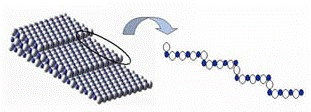Chemistry, Department of: Faculty Series

Marjorie A. Langell Publications
Document Type
Article
Date of this Version
July 2005
Abstract
The Fuchs–Kliewer phonon spectrum of single crystal Co3O4(110) has been treated with a Fourier transform log deconvolution method, which removes multiple scattering features from the single loss spectrum. Auger electron spectroscopy (AES), x-ray photoelectron spectroscopy (XPS) and low-energy electron diffraction (LEED) were first used to characterize the Co3O4 crystal establishing the cleanliness, composition, and order of the (110) surface. High resolution electron energy loss spectroscopy (HREELS) was then used to obtain the phonon spectrum for an incident electron energy of 3.77 eV. Due to the strong dipole cross section for the Fuchs–Kliewer phonon modes, intense multiple electron scattering was detected, which provided a complicated and overlapping combination of all possible loss modes. Deconvolution removed the multiple loss modes to produce well-resolved Fuchs–Kliewer fundamental phonon losses at 218, 373, 598, and 682 cm-1 (27.0, 46.2, 74.1, and 84.6 meV). These values are compared to the fundamental loss energies obtained by resolving the overlapping peak structure with standard peak fitting procedures, which confirmed the single loss energies obtained with the deconvolution procedure. Deconvolution results from the four fundamental phonon spectrum of single crystal Co3O4(110) were also compared to those from the simpler spectra of CoO(100) and thin-film CoO(100)–Co3O4 epitaxy and some practical aspects of the deconvolution process discussed in this context.


Comments
Published by American Vacuum Society. J. Vac. Sci. Technol. A 23(4), Jul/Aug 2005. ©2005 American Vacuum Society. Permission to use.